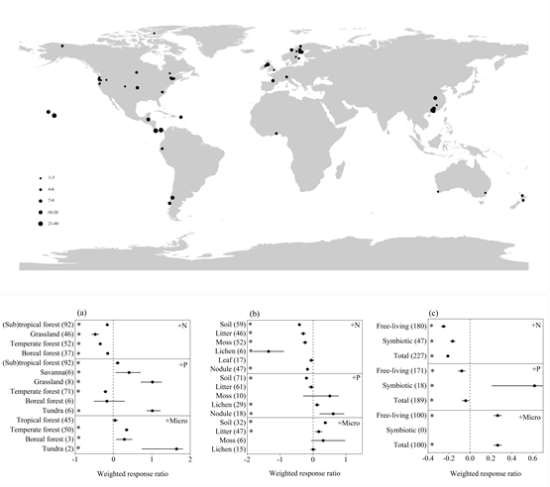Global Pattern and Controls of Biological Nitrogen Fixation under Nutrient Enrichment
Biological nitrogen (N) fixation (BNF), an important source of N in terrestrial ecosystems, plays a critical role in terrestrial nutrient cycling and net primary productivity. Currently, large uncertainty exists regarding how nutrient availability regulates terrestrial BNF and the drivers responsible for this process.
To address this knowledge gap, Dr. ZHENG Mianhai (under the guidance of Prof. MO Jiangming) and his colleagues from South China Botanical Garden of Chinese Academy of Sciences (SCBG, CAS) compiled a global database of free-living N fixation (in soil, litter, moss, lichen, and leaf) and symbiotic N fixation (in legume nodule) in response to N, phosphorus (P), and micronutrients (Micro) addition across different biomes (i.e., tropical/subtropical forest, savanna, temperate forest, grassland, boreal forest, and tundra) and examined whether fertilization regimes (nutrient-addition rates, duration, and total load) and environmental factors (mean annual temperature (MAT), mean annual precipitation (MAP), and background N deposition) affect the extent of BNF in response to nutrient addition.
They found that N addition inhibited terrestrial BNF (by 19.0%), Micro addition stimulated terrestrial BNF (by 30.4%), and P addition had an inconsistent effect on terrestrial BNF (i.e., inhibiting free-living N fixation (by 7.5%) and stimulating symbiotic N fixation (by 85.5%)).
Furthermore, the response ratios (i.e., effect sizes) of BNF to nutrient addition were smaller in low-latitude (<30°) biomes (8.5?36.9%) than in mid-/high-latitude (≥30°) biomes (32.9?61.3%), and the sensitivity (defined as the absolute value of response ratios) of BNF to nutrients in mid-/high-latitude biomes decreased with decreasing latitude (p≤0.009; linear/logarithmic regression models). Fertilization regimes did not affect this phenomenon (p>0.05), but environmental factors did affect it (p<0.001) because MAT, MAP, and N deposition accounted for 5?14%, 10?32%, and 7?18% of the variance in the BNF response ratios in cold (MAT<15°C), low-rainfall (MAP<2500 mm), and low-N-deposition (<7 kg ha-1 yr-1) biomes, respectively.
Overall, their study depicts a global pattern of nutrient impacts on terrestrial BNF and indicates that certain types of global change (i.e., warming, elevated precipitation and N deposition) may lead to declines in the nutrient constraints of BNF in mid-/high-latitude biomes.
The above findings have been published online in Global Change Biology (https://doi.org/10.1111/gcb.14705).

Fig. Effects of nutrient addition on biological nitrogen (N) fixation (BNF) across biomes (a), compartments (b), and N fixation types (c)
File Download: